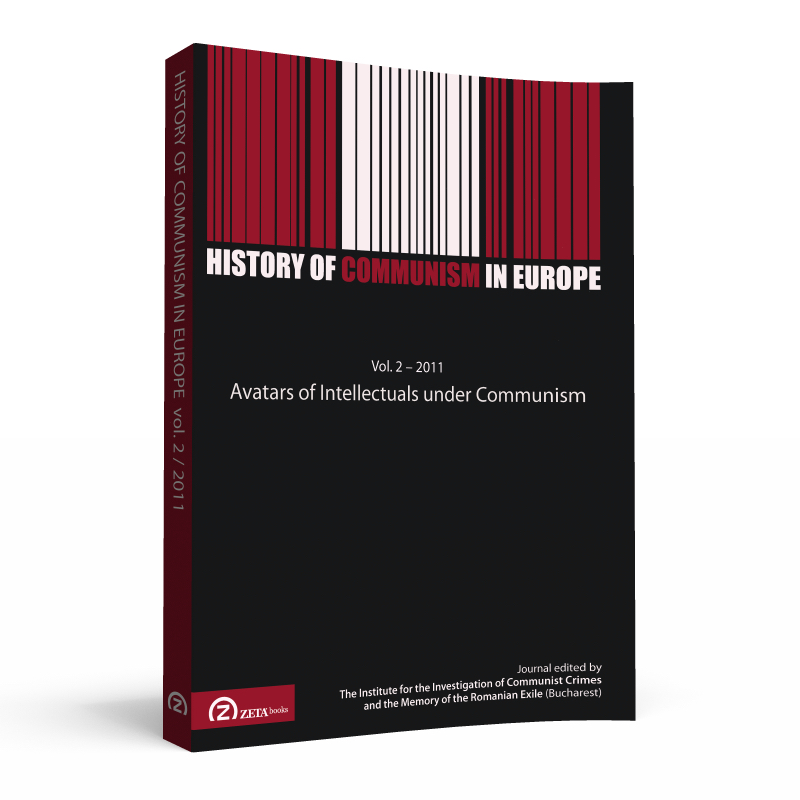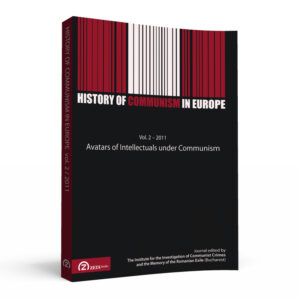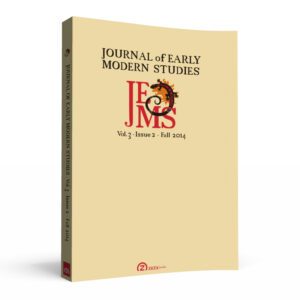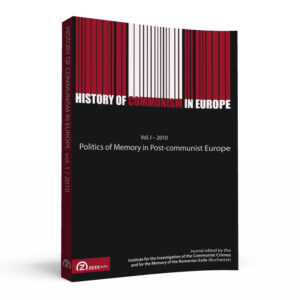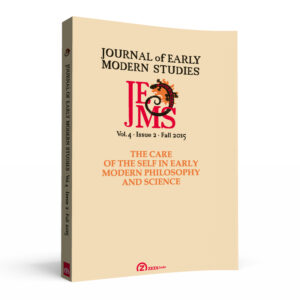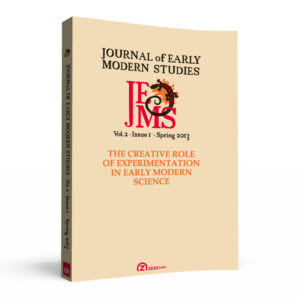CONTENTS
Cristian VASILE: Avatars of Intellectuals under communism
I. INTELLECTUALS AND THE UTOPIAN TEMPTATION
Andreea ZAMFIRA: Intellectuals’ Enthusiasm for Communism at the End of the First World War in France
- Abstract: This paper is both a description and an analysis of some of the most interesting cases of French intellectuals seduced by the communist project at the end of the First World War. While the major objective of this paper was to present the manner in which the communist ideology and the regimes inspired by this one afterwards were imagined and conceived by widely known intellectuals at that time, its secondary objective was to bring into debate a salient and, at the same time, somehow neglected issue in the academic literature – the intellectual attachment to the totalitarian ideas in Western Europe. The First World War made it possible that the utopian philosophies meet the political will of recreating a new social order and, also, it gave birth to a mass intellectual movement that, for the first time in the European history, has burst in the East side of the continent and influenced famous western intellectuals’ outlooks on culture, society and politics. Among the French intellectuals fascinated by Communism at the end of the First World War, we distinguished several types, any of them finding its sap in different sources of attraction. The first profile belongs to the «nostalgic intellectual», who has a particular admiration for the great events from the historical past, especially for the French Revolution of 1789. Alphonse Aulard is one French intellectual we considered as being attached to Communism due to its nostalgia. The «idealists», most of them Slavophile, form the second group of intellectuals. Pierre Pascal, as well as the other French Slavophiles, developed a sincere admiration, sometimes even naïve, for the old Russian society, perceived as the cradle of the orthodox religion and of the traditional community life. Thirdly, it is the «nonconformist» intellectual’s portrait that draws our attention. Both nonconformist and idealist intellectuals are conservative, rejecting certain modern phenomena. Nevertheless, unlike the idealist, the nonconformist intellectual does not oppose modernity per se; he only wants to recreate it as peaceful and tolerant. An outstanding nonconformist intellectual to be mentioned here is Romain Rolland. Finally, the fourth profile identified in this paper is the «modernist» or the «surrealist» Michel Winock wrote about. André Breton is one of the most renowned surrealist intellectuals who were fascinated by Communism in France. The surrealist intellectuals defended the idea of a new régime de l’esprit, proposing new aesthetic categories (the dream, the unconscious, the illogicality) and, thereby, getting closer to an aesthetic definition of the revolution and of a modern political project. Being based on a theoretical assertion resulting from François Furet’s writings, according to whom intellectuals’ enthusiasm for Communism had a double nature (ideological/ rational and aesthetic/ emotional), our analysis has taken into consideration both objective and subjective variables, such as: the profession, the way of perceiving modernity, the attachment to the communist cause, the political interests, the communist affiliation, etc.
Valentine LOMELLINI: Reassessing the Communist Utopia? Euro communist intellectuals at the mirror of the “developed socialism”
- Abstract: This article tries to provide some food for thought on the identities of the PCI and the PCF about the developed socialism, taking into consideration some relevant turning points in the ‘70s and three different case studies (the USSR, Czechoslovakia and Poland). Although it does not offer a complete analysis of Western Communist thinking on the image of developed socialism, it rather tries to reassess the common interpretation of some central features of the legacy of the developed socialism with respect to the two main Communist Parties of the Western bloc. Firstly, it argues that though many factors lay behind the strong tie between Western Communism and the Eastern communist states, the belief that developed socialism was reformable, mattered a great deal and, indeed, many leaders endorsed such a conviction. The Western leaders, and especially those of the Italian Communist Party, were arguably aware of the failures of developed socialism: particularly during the mid-‘70s, pessimism grew and was decisive in the creation of Eurocommunism. Nevertheless, the important role played by the Soviet Union in détente, and the conviction that the contradictions of the developed socialism could be resolved if the new course of the 20th Congress were restored, proved central in defining the image of developed socialism for Western Communists. Secondarily, the paper argues that historiography makes much of the differences between the PCI and the PCF: the first is usually considered more open, more democratic and capable of serious and genuine ideological evolution; while the latter is seen as a pro-Soviet Party, which used Eurocommunism as a tactic, and that lacked the capacity for autonomous thought. Though substantially agreeing on this distinction, more information is needed. We should stress that the thoughts of both Parties were based on the idea that a new political ruling class would have been able to change developed socialism. It would have brought about a new course, combining socialism and democracy or, at least, solving the contradictions within real socialism. Leadership was considered to be the key to changing the system. New Eastern heads and maybe also the Eurocommunist leadership would have been able to transform the system and set out a new path to socialism. The paper is based on archival resources recently made available, those of the Archivio Centrale del Partito Comunista Italiano – Fondazione Gramsci and of the Archive du Parti Communiste Français de la Seine-Saint Denis. Particular attention is given to press sources and interviews with former communist leaders.
Alina PAVELESCU: Idéologiser la culture alternative. Adrian Păunescu et le Cénacle Flacăra
- Résumé: Fondé en 1973 par le poète Adrian Păunescu, le Cénacle “Flacăra”, a été le phénomène le plus prodigieux de la propagande culturelle du régime Ceauşescu. Cette étude questionne le fonctionnement du cénacle sous l’angle du réseau relationnel des acteurs de cette propagande ainsi que de ses effets dans la culture politique de la jeunesse roumaine des années 1970-1980. L’analyse du Cénacle «Flacăra» rende compte du positionnement de son fondateur en tant qu’acteur actif de la propagande nationaliste du régime Ceauşescu, de la manière dont son action publique s’insère dans l’action des autres acteurs de la même catégorie, des buts de sa stratégie de confiscation de la culture alternative des jeunes et des moyens employés pour les atteindre.
II. ARTS AND CULTURE
Fjoralba SATKA: Albanian Alternative Painting vs. Official Painting under Communism
- Abstract: Behind the European Iron Curtain another “iron curtain” was drawn, between Albania and the rest of the socialist countries in Europe. Its architect was the dictator Enver Hoxha, who constructed Albanian national identity as a gated community based upon the dialectics of inclusion and exclusion. As a result, “socialist realism” Albanian art under communism can be differentiated clearly from art in other socialist countries. Political power and ideas on culture and particularly on painting meant birth of an official kind of art, parallel with an alternative art which I named painting in the shadow. The idea of painting in the shadow gives creators the possibility to operate on two levels. The first is the internal, psychologically sequential level of the creative process itself. This refers to selective activities and elaborate ideas using pictorial means from forbidden modern art – impressionism, expressionism, abstractionism. On the second level, artists operate beyond individual intentions just to indicate political position and rhetorical application of specific ideological regulations. Both levels are of interest to art practices in that they serve to reinforce artists’ position in official art in general, and to develop the artistic avatar on the private scene of painting in the shadow in particular. I am interested here in the first level, where avatars of Albanian artists under communism can be differentiated due to aspects of their styles and courage to react beyond the official rules. The basic problem with the contemporary interpretation of that unknown painting in the shadow is that it does not seem to take account of the fact that viewers nowadays are free to interpret, while painters were brought to heel in the face of the “method of socialist realism”.
Alice MOCĂNESCU: Artists and Political Power: The Functioning of the Romanian Artists’ Union during the Ceauşescu Era, 1965-1975
- Abstract: This article explores the relationship between artists and the communist political power through a case study of the way in which Uniunea Artiştilor Plastici (Romanian Artists’ Union) functioned from 1965 to 1975. Based on the research at the Romanian Artists’ Union’s archive (Central Historical National Archives, Bucharest), this article seeks to map out the twisted and ambiguous relationship that developed between artists and the Ceauşescu regime, during a period of increased ideological pollution and scarcity of resources. Several issues will be addressed in this article. Firstly, it will look at artists’ reaction to the regime’s early attempts to win them over and to consolidate its power by using a mixture of captatio benevolentiae, persuasion and coercion techniques. More precisely, the article will look at how artists received and responded to the overt use of nationalist discourse in the field of fine arts, the augmentation of acquisition funds and the diversification of institutions involved in this process immediately after 1965. Secondly, this essay will explore the actual tools and mechanisms used by the Ceauşescu leadership to mold art production in line with the State’s cultural policy. More precisely, starting in the 1970s, the stricter ideological control and the cuts in funding led to deep transformations inside the Union. This line of investigation will analyze the new policy for exhibition, the requirements and making of thematic exhibitions, distribution of funds or of other advantages (loans, personal exhibitions, trips abroad, etc), which contributed to a polarization of the Union’s members and to an increased competition for limited resources. Thirdly, the article will look into the transformation of the Union’s leadership into an elitist body that started to monopolize resources and distribution of “privileges”, a practice that ultimately led to vocal protests from rank and file members of the Union.
Nataliya HRISTOVA: Des masques au mascarade. Les intellectuels et les défis de la mémoire sociale (Milieu des années 1950 – fin des années 1990)
- Résumé: L’article analyse les différentes attitudes des représentants de l’Intelligentsia bulgare (notamment des écrivains) dès le milieu des années 1950 et jusqu’à la fin des années 1980, et leurs comportements publiques durant la première décennie post-socialiste (les années 1990). Le choix des personnages est non seulement « subjectif » (expliqué par le désir d’illustrer certaines tendances de la vie culturelle à travers les attitudes de certains représentants célèbres de l’Intelligentsia), mais également déterminé par les documents d’archive, sur la base desquels nous avons élaboré cette reconstruction historique. Ainsi, nous avons utilisé différentes sources, par exemple des enquêtes littéraires, des mémoires et des entretiens. Pendant le socialisme, et surtout à partir des années 1960, le pouvoir avait déjà acquis une physionomie nouvelle, plus « expérimentée », politiquement plus « maturée ». Ses rapports avec l’intelligentsia (surtout avec le milieu artistique) sont habiles, et aussi très mobiles. Les différents événements politiques, la modification des accents idéologiques ou l’ éclatement des scandales culturels emmènent une pluralité de réactions et de mesures. Certaines attitudes générales en dérivent au cours de trois décennies: la riposte et l’opposition; le “silence”,et l’acceptation des privilèges, le conformisme.
Shawn CLYBOR: Socialist (Sur)Realism: Karel Teige, Ladislav Štoll and the Politics of Communist Culture in Czechoslovakia
- Abstract: This article focuses on the relationship between two Czech communist intellectuals whose ideas it attempts to situate in the broader history of twentieth-century Czechoslovakia: Karel Teige (1900-1951), a leading member of the European avant-garde; and Ladislav Štoll (1902-1981), a prominent journalist in the Communist Party of Czechoslovakia. Standard historical accounts have used morally simplistic categories to create a stark opposition between Teige and Štoll: After the communist seizure of power in 1948, the former suffered intense repression for his heretical support of the avant-garde, whereas the latter became a leading architect of Zhdanovite socialist realism. The goal of this article, however, is to problematize such oppositions by focusing instead on the many intellectual and political commonalties both men shared. In doing so it undermines the Cold War myth of a communist monolith imposed from above that separated the ideologically loyal from those who refused to tow the official line. Drawing upon a range of archival and secondary sources, the article demonstrates that until 1950, the Communist Party of Czechoslovakia never had a monolithic “line” on art and culture, making it anachronistic to impose concrete boundaries between “true believers” and intellectual “heretics.” To the contrary, Teige insisted throughout his life that his avant-garde aesthetics (which he based on French Surrealism and Russian Constructivism) were consistent with the Soviet doctrine of socialist realism. At the same time, Party functionaries such as Štoll largely tolerated, if not agreed with such opinions—despite how greatly such opinions deviated from the Soviet norm after 1937.
III. COMMUNIST COMMUNITIES OF EXPERT KNOWLEDGE
Ștefan BOSOMITU: Notes and Remarks on the (Re) Institutionalization of Sociology in Communist Romania in the 1960s
- Abstract: This paper aims to evaluate the place of Romanian sociology during the communist regime by trying to reconstruct the regional and internal political context which led to the (re) institutionalization of that discipline. After experiencing a fertile period between the wars, Romanian sociology was “banned” at the end of WWII and the establishment of the communist regime. After two decades of “misery”, sociology was once again institutionalized in the mid 1960s in the context of an intellectual and political “liberalization”. The paper tries to explain the institutional development of Romanian sociology within Michael Voříšek’s methodological framework, discussing a series of indicators of a discipline’s institutionalization: research, teaching, professional organization, discourse, and label. The paper also analyzes the role of diverse factors (prewar tradition, political regime) in the development of sociology after WWII. It concludes by explaining that the tortuous process of institutionalization was due to the necessity to find the right timing when sociology was to be accepted as a legitimate and useful discipline, but also to the fact that sociology was only then able to individualize itself within the theoretical and ideological complex of Marxism-Leninism.
Bogdan IACOB: Co-option and Control: The Changing Profile of the Historical Front in Communist Romania at the End of the Fifties
- Abstract: The 1948 transformation of the Academy, combined with extensive purges of the higher education system qualifies as a Great Break, Romanian style, within the scientific field. In 1955, at the 2nd RWP Congress, the communist regime adopted, within the academic realm, an approach of simultaneously fulfilling the goals of the cultural revolution and promoting the reformed old intelligentsia, compliant bourgeois specialists. As the RWP was searching for an identity in the context of de-Stalinization, the role of science changed, bringing along with it significant transformations both at a personnel and thematic level. The RWP targeted both co-option and control. It is the thesis of the present article that from 1955 to 1963 the historical front gained a polycentric profile. Various groups converged towards the same point: the creation of both the ideological and infrastructural basis for the master narrative about Romania’s evolution into socialism. Once the axiomatic but creative role of the present in making sense of the national past was commonly accepted, a new productive equilibrium was reached on the historical front.
Nevena DIMOVA: Macedonian and Albanian Intellectuals and the National Idea(s) in Socialist Macedonia
- Abstract: This article looks at the relations between Macedonian and Albanian intellectuals and the communist party in the Republic of Macedonia. More specifically, it focuses on the creation and development of national program by Macedonian intellectuals within state structure. The article argues that during the socialist period the party policies and the socialist Macedonian intellectuals were supporting each other in the realization of their common goals: the establishment and consolidation of the Macedonian national program. It looks at intellectual production created by members of the Macedonian Academy of Arts and Sciences (MANU) to show how historiography and linguistics became the battlefields for the development of national ideology in Macedonia. Based on the establishment of these “invented” traditions, Macedonian scholars and socialist politicians made claims within Yugoslavia, but also internationally that Macedonians are a separate nation and that they have the right to an independent state after socialism. I show that Albanian intellectuals also developed an Albanian national program, only quietly and in the background. Simultaneously, the article argues that the Yugoslav policies of national determination, decentralization and self-expression reinforced ethnic differences in the country and assisted in the development of Albanian and Macedonian parallel national projects. The processes of inclusion and national consolidation, while excluding ‘the others’ from the national project, were legitimized and institutionalized by the creation of a national culture and politics by the intellectuals within the socialist state structures.
Luciana JINGA: Intellectuelles ou apparatchiks. Les politiques pour la promotion des femmes dans le Parti Communiste Roumain
- Résumé: L’État communiste roumain s’est appuyé dans sa politique concernant le statut des femmes sur deux principaux piliers: la loi (prétendument égalitaire) et partis communistes de la région. Une particularité du cas roumain a été, en revanche, la promotion constante des femmes dans le parti et le suivi attentif des pourcentages. Cependant, malgré les mesures proactives prises dans les années 1970 et 1980, la représentation féminine au sein du PCR n’a jamais dépassé 36%. Une présence numériquement importante au sein du parti n’a pas conduit à une représentation similaire dans les instances politiques dirigeantes. Ici aussi, notre étude nous a permis de nuancer les appréciations et de mettre en évidence une disparité entre les organes locaux et les organes centraux du parti. Dans les comités du parti au niveau départemental, le pourcentage de femmes était à peu près le même (sinon plus élevé) que la moyenne nationale des femmes membres du parti. Au contraire, dans les instances centrales notamment dans le Comité Central, le Comité Politique Exécutif ou son Bureau, la présence des femmes restait plutôt une exception. Le cumul des fonctions a toutefois donné au niveau de l’opinion publique l’image d’une omniprésence féminine dans les postes de direction, aussi bien dans les organismes civiques que dans les instances du parti et les institutions d’Etat. Il nous a semblé intéressant de confronter cette image commune avec la situation réelle. L’analyse attentive des différentes instances nous a permis d’identifier un groupe dirigeant formé par les femmes membres du parti «cumulardes». Il ne comprenait pas plus de 30 à 40 personnes. Le portrait général des femmes membres du parti, élues au Comité Central Parti Communiste Roumain, diffère de l’image stéréotypée de l’ouvrière analphabète, militante du parti, promue uniquement pour l’adhésion totale au parti et moins pour des raisons méritocratiques. Depuis octobre 1945, la proportion des intellectuelles a été significative, même majoritaire pendant des deux décennies. Comme pour l’organisation féminine de masse, le Parti Communiste Roumain a désigné comme représentantes au Comité Central des femmes sur lesquelles on pouvait compter du point de vue professionnel et intellectuellement.
Márta ERDŐS, Gábor KELEMEN: The Finite Universe: Discursive Double Bind and Parrhesia in State Socialism
- Abstract: Readers are invited into a universe established by the discursive practices of “soft dictatorship” in Hungary between 1957 and 1989. The two major categories of our epistemic discourse analysis, representing the internal struggles of the intellectuals in the era, are manipulation and parrhesia. Manipulation is understood as an abuse of power; it impairs human collaboration and social development by delimiting social participation. Parrhesia is an act in which the speaker expresses his personal relationship to truth, taking the risks and responsibilities of veridiction in crisis situations. A most effective form of manipulation is maintaining double bind relations by certain discursive techniques. Double bind is a habitual practice of molding one’s long-term expectations on social contexts: one’s physical and/or psychological survival is at stake, but escape is made impossible. When helpless attitudes have been formed, due to confusion over inconsistent messages, no external threat is necessary any more. Double bind relations may result in self-destructive forms of behavior, the construction of false selves, passivity and a visionless approach to life. Occasionally, it may foster transcontextual creativity, representing a precious but transitory resource for intellectuals to practice critical reflectivity. The authors analyze here contemporary texts (political speeches, philosophical papers, literary works, jokes and a film). Portraits of intellectuals reveal that the immense power of truth and the inability to confess it is a torture in any communist system. There are many victims of a dictatorship: those who were killed or prosecuted; the victims who could survive but society has not responded to their traumatic experiences; those who tried to find compromises and found a purposeless life instead; those who believed in a single truth and were deceived; and those who were actively searching for truth and came to the conclusion that there might be many faces of truth – but none of these can be seen clearly in a false social context.
IV. DISSENT
Iulia VLADIMIROV: Monica Lovinescu: The Voice of Unbound Freedom
- Abstract: Starting with 1962, Monica Lovinescu became, for hundreds of thousands of Romanians, the voice of unbound freedom as editor with Radio Free Europe. Her well-known broadcasts, Theses and Antitheses in Paris and The Romanian Cultural Bulletin, revealed the true face of communist Romania while openly discussing the fate of literature, art, music or politics under dictatorship. Monica Lovinescu’s well-grounded opinions and her determination never to compromise made her a living example of moral integrity, which exiled and non-exiled Romanians constantly referred to. The impact of Monica Lovinescu’s live transmissions forced the Romanian Securitate to initiate and develop deftly devised plans to marginalize, belittle or even “neutralise” the rebellious “element”. Lovinescu’s refusal to collaborate with the communist authorities was followed by hostile press campaigns, close surveillance by the Securitate officers and informants and, last but not least, an act of violent physical aggression against her in November 1977. Monica Lovinescu’s opposition to the communist regime continued, irrespective of the Securitate’s opening or closing her file. The Romanian Revolution of 1989 marked the beginning of a new stage in Lovinescu’s career. She spoke as openly about the need for lustration and in favour of democratic values. Her unparalleled contribution to the cause of freedom needs to be properly assessed.
Cosmina TĂNĂSOIU: Revisiting Romanian Dissent under Communism. The Unbearable Lightness of Solitude
- Abstract: Explanations for the relative silence of Romanian intellectuals between 1945 and 1989 vary, though all centre upon the regime’s ability to coerce and control intellectual circles through its repressive and manipulative tools, such as its political police (the Securitate), a nationalist discourse that equated opposition with betrayal and an incentive-based approach (economic and social benefits). While structural constraints as well as a particular nationalistic culture, explain the limited dissent, they do not account for why dissent happened at all. This article focuses on agency as well as context examining not just the factors that influenced dissent but also analyzing the various forms of dissent which occurred during communism. It takes a historical analysis approach and relies upon a dataset obtained through original, open-ended interviews with leading Romanian intellectuals and primary sources (i.e. memoirs, open letters) to explain and analyze intellectual dissent. The article argues that individual acts of dissent show that despite the sophisticated mechanisms of indoctrination, propaganda and control, the party’s ability to atomize society was not absolute. Such Quijotic acts provided society with reference points outside the sphere of the Party itself and the grey zone of ethical minimalism.
Ana-Maria CĂTĂNUȘ: Breaking the barriers of Romanian conformism. Dissent and scientific critique of Communism in mathematician Mihai Botez’ thinking. A case study
- Abstract: This study discusses the case of mathematician and futurologist Mihai Botez, one of the most important Romanian dissident thinkers in the 1980s. Using unedited documents from personal archives, documents from the archives of the former Securitate, Radio Free Europe, as well as oral history sources, this study emphasizes how Mihai Botez’s dissidence emerged, the main directions of his dissident project, similarities in terms of ideas with other dissidents in Eastern Europe/Soviet Union, the relevance of his dissent in relation to Communist power and Romanian society. The study consists of two parts, each divided in several sub-themes. The first part of this study deals with investigating the intellectual roots of Botez’s dissident thinking, discussing also the influence that his professional education had on the rise of his political consciousness. It also discusses the main directions of Mihai Botez’s dissidence: the conceptualization of solitary dissidence as a first step towards individualizing a group of independent critical intellectuals, dissident strategies, and expected results. The second part deals with Mihai Botez’s works and research aimed at developing the cybernetics of Communist regimes. His dissident project aimed at bringing to light the parallel society that existed but which kept silent, encouraging diversity of views and creating pressure from society, one capable of influencing government strategies. Finally, we will dedicate few pages to how Botez’s dissent was perceived in Romanian society before and after 1989, the perpetuation of theories and rumors of his being a Securitate collaborator, and how this affected the collective image of the value of his dissident activity.
V. REVIEWS
- Corina DOBOȘ: Vladimir TISMĂNEANU (ed.), Promises of 1968. Crisis, Illusion, and Utopia, Budapest-New York: Central European University Press, 2011;
- Florea IONICIOAIA: Grégoire GAFENCO/ Grigore GAFENCU, Préliminaires de la guerre à l’est, De l’accord de Moscou (21 août 1939) aux hostilités en Russie (22 juin 1941)/ Preliminariile războiului din răsărit, De la Acordul de la Moscova (23 august 1939) până la ostilităţile din Rusia (22 iunie 1941), ediție bilingvă, Avant-propos par/ Cuvânt-înainte de Teodor Baconschi, Préface,notes et index par/ Prefaţă, note şi indice de Laurenţiu Constantiniu, Traduction par Andrei Niculescu, Colecţia: Seria Grigore Gafencu, București: Editura Curtea Veche, 2011;
- Raluca GROSESCU: Stephen KOTKIN, Jan GROSS, The Uncivil Society: 1989 and the Implosion of the Communist Establishment, New York: Modern Library, 2009;
- Dumitru LĂCĂTUŞU: Mircea STĂNESCU, Reeducarea în România comunistă (1948-1955). Târgșor și Gherla, Iași: Polirom, 2010;
- Andrei MURARU: Charles KING, Odessa: Genius and Death in the City of Dreams, W.W. Norton & Company, New York-London, 2011
NOTES ON CONTRIBUTORS
- ISSN: 2069-3192 (paperback)
- ISSN: 2069-3206 (electronic)
- ISBN: 978-606-8266-14-5 (paperback)
- ISBN: 978-606-8266-15-2 (ebook)

